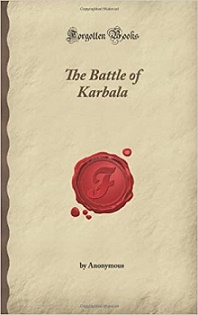The Battle of Karbala (Book)
The book The Battle of Karbala is an excellent piece of literature that everyone wants to know more about.
 | |
| Language | English |
|---|---|
| Published | 2008 |
| Publisher | Forgotten Books |
| Pages | 130 |
About the PublisherEdit
Forgotten Books is a publisher of historical writings, such as: Philosophy, Classics, Science, Religion, Esoteric and Mythology.
About the BookEdit
This book published by Forgotten Books (January 28, 2008), has 130 pages and best sellers rank of 722,696 in Books.
It is advised that this book is a little hard to read without an Arabic background, but it advances the story in a balanced and healthy tone.
Abstract of chaptersEdit
A Biography Of `abdul-zahrÁ' Al-ka`bee (mmauh)Edit
This part is a little preview over the famous narrator of this epical battle, Sheik ‘Abdul-Zahra’ AI-Ka'bee, whose famous voice is always in the minds of Shiites all around the world.
IntroductionEdit
This part is a word about the revolution of AI-Husayn and what were the goals and what are the benefits that Islam gained in return after such a massacre that reached the grandson of the prophet, Al-Husayn, and his companions.
The Battle of Karbala (the fight between goodness and evil) took place on 10 Muharram 61 AH (October 9 or 10, 680 AD) in Karbala, Iraq today. On one side were supporters and relatives of Muhammad's grandson Husayn ibn Ali (72 men); on the other side was a military detachment from the forces of Yazid, the Umayyad caliph (at least 40,000 men).
The First PartEdit
This part is the story of Ashura itself. It tells what happened aftre the death of Imam Al-Husayn until his household turned back to Medina was broadcasted from the station of Baghdad on the morning of Arbaeen in the year 1379 A.H. and 1380 A.H.
This battle also had significant effects on formation of subsequent revolts against the Umayyad dynasty.
The Second PartEdit
This part is the story of the prisoners of women and children of AI-Husayn who were captured as prisoners and their journey in captivity from Karbala in Iraq to Damascus, the capital of the Umayyad state, then back to Karbala then back to Medina (40 days passing the martyrdom of the eternal hero and the first revolutionist in Islam).